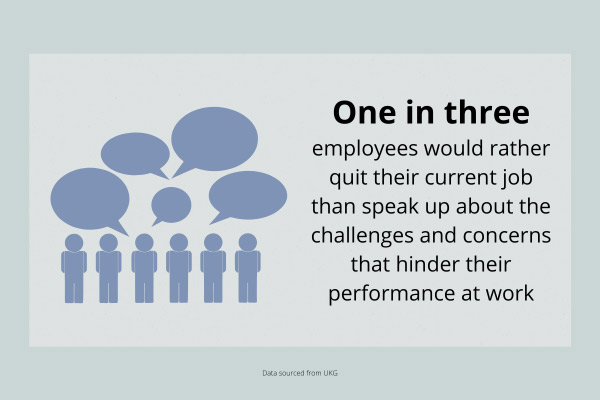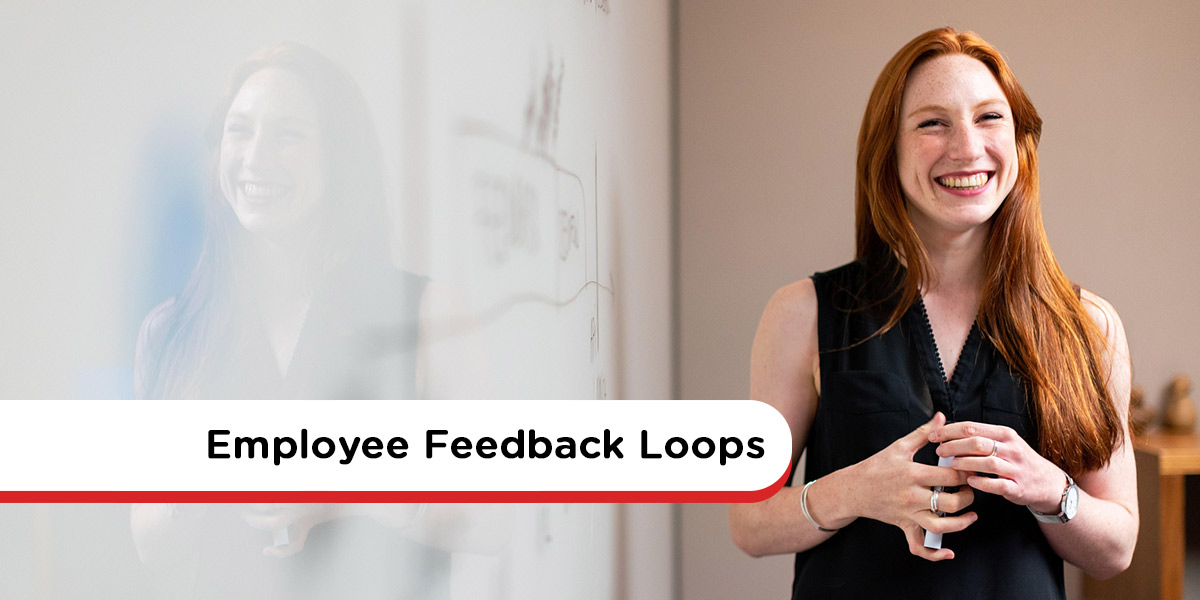Of all the things that help you cultivate a happy, motivated workforce, integrating employee feedback loops to ensure employees are heard, valued, and empowered is arguably the most important.
Competitive salaries and compensation packages can only get you so far with the modern workforce. They want to work for companies that listen to their opinions, respond to their feedback with tangible changes, and support them in their professional development.
As the beating heart of your business, it isn’t much to ask. And yet, only three in ten employees believe that their opinions count at work according to Gallup research.

Image sourced from Gallup.com
An employee feedback loop is a simple but effective way to foster a work culture that values transparency, openness, and respect — all while driving positive change and improvements. So, let’s explore what employee feedback loops are and how you can integrate them into your workplace.
What are employee feedback loops?
An employee feedback loop is a continuous, two-way communication cycle of feedback between a company’s leadership and its employees. Employees are encouraged to provide authentic feedback to leaders, and leaders are tasked with using this feedback to implement positive changes and communicate them back to employees.
Feedback loops can also involve providing employees with constructive criticism, praise, and suggestions to help them improve their performance and skills.
There are four main stages in an employee feedback loop: collection, analysis, action, and communication.
- Collecting feedback: The first step involves creating a safe space where employees are encouraged to voice their honest opinions. Feedback can be collected openly or anonymously using various methods.
- Analyzing feedback: The next step involves analyzing the feedback to detect common areas of concern.
- Taking action: This is where you actively address communicated issues. Make a plan that targets problem areas head-on and get to work implementing changes.
- Communicating findings: Keep employees in the know by communicating the results of the feedback analysis as well as the changes you’ve made in response. From there, you can continue to ask for feedback to gauge the success of your improvements.
How feedback loops enhance workplace culture
The impact of feedback loops on workplace culture is far-reaching, capable of fostering open communication, transparency, trust, motivation, engagement, and more.
Fosters open communication and transparency
Poor, inauthentic communication between employees and leadership can lead to distrust, reduced morale, and employee turnover. Recent research by UKG found that one in three employees would rather quit than speak up about their challenges and concerns.
This is a harmful yet common occurrence when businesses fail to create an open, transparent work culture.

Image created by writer, and data sourced from ukg.com
Feedback loops cultivate a culture of transparency and openness by encouraging open dialogue — criticisms as well as praise — between employers and leaders. Even more importantly, it demonstrates the value of this dialogue by using it to directly address issues, further incentivizing employees to share their honest opinions.
Builds trust and promotes effective collaboration
Feedback loops encourage leaders to collaborate with employees to drive positive and mutually beneficial change. This unifies goals and helps to foster trusting relationships where employees have confidence in leadership’s vow to listen to and act on their feedback.
Enhances employee engagement and motivation at work
Organizational success relies on engaged, motivated, and productive employees — and yet, 77% of workers feel disengaged at work, according to Gallup’s report.
Continuous feedback loops tackle employee disengagement by demonstrating to employees that their opinions are valued and that their input is instrumental in shaping the environment they work in.
As a result, employees feel more connected to their workplace, nurturing a sense of belonging and commitment that boosts morale, engagement, and motivation.

Free-to-use image sourced from Pexels
Encourages continuous growth and adaptability within teams
Employee feedback is a two-way street that encourages continuous growth on organizational and individual levels.
Honest feedback from employees offers key insights into company-wide concerns and areas for improvement, which, when addressed, can increase productivity, adaptability, and growth. For example, large-scale objectives like enterprise architecture as strategy can be realized through employee input.
Essentially, it gives employees control over, and awareness of, transformative business changes, leading to a more agile and adaptable workforce.
And, when leaders respond in kind by delivering honest feedback to employees, it empowers them to enhance their skills, capabilities, and performance.
Reduces conflicts by addressing concerns proactively
The longer your employees’ concerns are left to fester, the more dangerous they become. Remember, one in three employees would rather quit their job than voice their concerns, an action that’s often the result of building tensions and prolonged dissatisfaction.
And, if an employee’s concerns are consistently ignored, it can escalate conflict and lead to toxic work environments and high turnover.
With continuous feedback loops in place, employees can safely voice their concerns as soon as they arise. This empowers leaders to proactively address issues before they escalate.
How to create effective employee feedback loops
Integrating employee feedback loops into your workplace is fairly simple, but there are a few best practices to follow to ensure that you reap all the benefits.
Clarify the purpose behind the feedback loop
Start by clarifying your main reasons for implementing an employee feedback loop.
Your goals might be performance-based, such as aiming to boost engagement or team productivity. They could also be wellness-based if you’re striving to improve employee satisfaction or reduce turnover.
Alternatively, your primary goal might be to steer operational improvements, such as using employee feedback to pinpoint technological challenges and inform solution architecture initiatives aided by Ardoq, for example.

Free-to-use image sourced from Unsplash
Outlining and communicating the purpose behind the feedback loop will help you develop a clear strategy and secure the support of stakeholders and employees.
Select effective channels for feedback communication
There are plenty of different ways that you can collect feedback manually — via physical suggestion boxes, employee surveys, and one-on-one or team meetings, for example.
However, adopting a digital approach gives you the opportunity to collect feedback in real time, accelerating action.
Digital tools you can leverage include:
- Communication tools: Employees and leaders can deliver feedback in real time via phone call, SMS, instant message, and video with a cloud PBX phone system, streamlining two-way communication. Cloud communications software also comes with features like call analytics and call recordings, enabling you to collect data that can be used to personalize employee feedback.
- Survey platforms: Survey platforms let you create surveys, gather 360-degree feedback, and analyze the results all in one platform. Pulse surveys are particularly effective at gaining immediate, actionable feedback.
- Employee engagement software: Employee engagement software centralizes your feedback loop. Employees can give and receive feedback on one platform, promoting convenience and accessibility. Also, managers can track and analyze feedback, set goals, monitor performance, and more. If you opt to create your own employee engagement app, don’t forget to conduct synthetic monitoring before asking employees to use it. This will help ensure you catch any app issues and resolve them before they affect your actual users.
- Intranet platform: For a more collaborative approach, consider using an intranet platform. The best intranets can facilitate many feedback processes, such as pulse surveys or virtual suggestion boards, where employees can post their ideas and receive immediate feedback from colleagues and managers.
Adopting a digital approach to your feedback loop works alongside your wider cloud modernization strategy. It streamlines internal communications, promoting unified, stress-free communication experiences.
Schedule regular feedback sessions for consistency
For employees to trust in your feedback loop, it needs to be consistent. So, aim to schedule regular feedback sessions — either weekly, monthly, or quarterly — with your employees. Regularity instills employee confidence as it demonstrates that you continue to value your employees’ opinions weeks, months, and years down the line.
Ensure feedback is specific, actionable, and constructive
Vague, unconstructive feedback causes misunderstandings, conflicts, and inaction. So when leaders deliver feedback to employees, it must be specific, actionable, and constructive.
For example, simply telling an employee that they’re always missing deadlines is demoralizing and doesn’t motivate development. A more actionable, constructive way to deliver the feedback would be to say, “You need to work on your time-management skills to overcome the difficulty you have when it comes to meeting deadlines.”
From there, you can collaboratively identify time-management strategies to guide growth and development.
When seeking feedback from employees, don’t be afraid to press them for more information if their feedback is too vague or unconstructive. Remember to emphasize that you value honesty and openness to motivate employees to voice their authentic opinions.
Enable two-way communication for mutual feedback
How easy is it for employees and leadership to communicate feedback? Empower employees to engage in two-way dialogue with leadership by using your internal communication tools and engagement platforms.

Free-to-use image sourced from Pexels
You should also aim to promote an open-door policy to encourage open, honest communication. This fosters trust and leads to improvements that are mutually beneficial for both parties.
Implement changes based on feedback received
Taking action based on the data you’ve gathered is the most important stage of the feedback loop. It’s how you demonstrate that you’re not just listening to employees, but actively responding to their concerns.
So, once you’ve identified areas for improvement, create an action plan and get to work implementing changes.
Of course, you might not be able to take every suggestion on board. Modeling your business capabilities can help you understand your organization’s current capacities, providing insight into the viability of transformative changes and informing strategic planning.
For more insight into “What is a business capability?”, leverage online resources and adopt a Business Capability Modelling solution.
Final thoughts
Employee feedback loops empower employees to play an instrumental role in driving positive change. From operational and technological challenges to critical cultural issues, employees can pinpoint areas for improvement that go unnoticed by leadership.
Plus, feedback loops improve workplace culture, cultivating an environment of open communication, collaboration, trust, and growth.
Using digital tools, collect feedback data and analyze it to identify improvement priorities and make targeted changes. And remember, feedback goes both ways, so deliver actionable, constructive feedback to employees in return.

